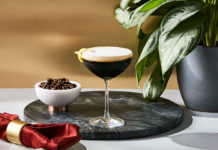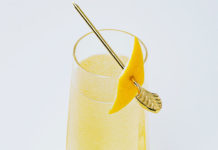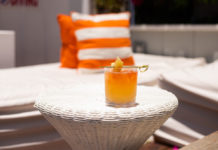
The latest craft beer trends and suggestions to serve up in your bar.
By Tanya Lawrence

It wasn’t too long ago that I was standing in line at an ice cream parlor in Berkley, California pondering over which enticing flavor to get. In town celebrating Cantillon’s annual
Zwanze Day at Mikkeller San Francisco, and hence having beer on the brain, I quipped that the shop’s offerings—a peanut butter cocoa nib, hazelnut marshmallow, toasted coconut espresso, and hazelnut amaretto crunch—read more like a taproom’s stout list than a roster of gelato flavors. My group laughed, only I wasn’t joking.
For craft brewers and breweries, 2017 was a year of experimentation and innovation. It was one of emergent trends, reimagined styles, and novel practices in both packaging and ingredient implementation. It was a year of pastry stout adjuncts comparable to sundae toppings; of double, triple, and quadruple IPAs; and of chucking hundreds of pounds of whole burger buns and French fries into the boil (God speed, Omnipollo).
For craft, 2017 was not only a year of pushing boundaries, but one of immense, rapid growth as well. Whereas overall beer volume sales throughout the United States remained largely static over the past two years, craft beer sales, according to the Brewers Association, continued to increase at a rate of 6.2%, reaching over twelve percent of the national beer market by volume.
Correspondingly so, retail dollar sales increased roughly ten percent, and today—with more than 6,000 breweries in operation—craft now accounts for nearly one-quarter of the nation’s 107.6 billion dollar beer market.
So what is next for this fast-growing, impactful market? What styles, practices, and discernible trends can we expect to see in craft beer in the coming year? Take a look at the trends below along with some suggestions for each category in the side columns.
A return to the
pilsner and craft lager
Pilsner and pale lager is a category of style including everything from American lager and Helles to Bohemian- and German-style Pils and crushable Mexican lagers. It has long been favored amongst American beer consumers for its clean, crisp taste; medium to high carbonation; and moderate (4.1% to 5.6%) alcohol content. While recent years have seen brewers pushing boundaries in regards to flavor profiles, brewers too understand both the importance of drinkability and beauty in simplicity, hence promoting a return to well-crafted traditional styles.
Lower-ABV IPA
There’s no question that high-strength beer has skyrocketed in popularity amongst consumers over the past few years, with an estimated 10% of all craft beer sold last year ringing in at 7.0% ABV or higher. With most commercial imperial India Pale Ale weighing in between 7.6% to 10.6% ABV, and other triple and quadruple styles topping out
at as much as 14%, drinkability
has become a recent focus. The coupling of high bitterness and
high alcohol content oftentimes encourage a “one and done” experience. The lower-ABV session IPA packs all the flavor and character of an imperial IPA in a package or pint that your guests can enjoy a few of.
A continued trend towards NEIPA and Milkshake IPA
Despite its controversy, NEIPA (New England or northeast IPA)—a regional, unfiltered adaptation of IPA characterized
by an intentionally cloudy or hazy appearance and smooth, creamy mouthfeel with little to no hop bitterness and notes of tropical fruit—has become popular amongst consumers and brewers alike. Believed to have first originated with the inception of Vermont-based The Alchemist’s Heady Topper, NEIPA has been popularized the nation over, with more breweries producing it and more people wanting to drink it. Nowadays, consumers desire more flavor and not necessarily more bitterness. These individuals are opting for beers with softer hop profiles and big aromatics, which both the NEIPA and milkshake IPA—essentially a NEIPA to which lactose, oats, and high-pectin fruit has been added—provide.
Non-adjunct stouts
and non-adjunct
barrel-aged stouts
Even though last year lower-ABV session IPAs saw a growth in sales of over 199% (according to the Brewers Association), stouts remain a favorite amongst craft beer enthusiasts. Once thought to be seasonally driven, stouts are increasingly being enjoyed year-round. They are trending subtly away from the adjunct-laden pastry bombs of the year previous and towards classic non-adjunct versions that showcase the brewers’ capacities and highlight the more traditional notes of bittersweet chocolate, coffee, roasted malt, etc.
Approachable wild
or sour beers
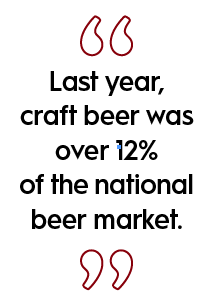
If you ask someone to provide tasting notes on any of the sub-categories of wild-sour beer—be it Brett, American Sour, Gose, Flanders, Fruited Lambic, or Gueuze—you’ll hear descriptors such as “lemony,” “leathery,” “floral,” “cheesy,” “horsey,” and even “goat-like.” The flavors that make these beers so beloved by craft enthusiasts are the same that many others find unpalatable. Nevertheless, interest in sour beer prevails. In the coming year, consumers will have their pick of beautiful, fruited Gose; dry-hopped or fruited kettle sours; and even sour IPA, which is a hybrid that’s bridging the gap between the two seemingly different, highly popularized styles.
A focus on local
In a consumer survey conducted by the Nielsen Company, 45% of people over the age of 21 reported that whether or not a beer is produced locally is “very important or somewhat important” in their decision to purchase the beer. The continued patronage of small, independent local breweries and taprooms, the utilization of sustainable ingredients, and
the implementation of high-quality fruits from neighboring farms,
will continue to shape our craft landscape. It will result in beer that has not only a sense of place, but a sense of community identity and significance as well.
Tanya Lawrence is a graduate of George Washington University in Washington, DC. A former territory manager at Big Top Brewing in Sarasota, Florida, she moderates the Instagram page babels_cameron dedicated to craft beer and craft beer tourism throughout the United States. She currently lives in Cleveland, Ohio and enjoys bird-watching and cheeseboards.
HEINEKEN USA has announced the introduction of a new draught beer system that delivers a premium draught beer experience to on-premise accounts that may have considered their beer volume too low to warrant the investment.
HEINEKEN USA touts this new table-top draught system, called Blade, as a way for smaller volume accounts to boost their beer profits with a unique draught system that guarantees brewery-fresh draught for 30 days and—with nearly 100% yield—ensures less waste. Blade fits on a countertop in a 12-by-19-inch area, requires no cleaning or maintenance, no installation, and weighs only 38 lbs.
Blade operates with HEINEKEN USA’s proprietary BrewLock® system that pushes air between multiple layers within an eight-liter disposable PET keg, squeezing the inner wall and driving the beer out. The beer remains untouched by outside influences and is served only with the natural carbonation that is already in the beer. Blade requires no keg deposit or costly line cleaning or CO2.
“The unique Blade system guarantees fresh draught even when you only serve a couple of glasses a day or a week,” says Cormac McCarthy, Project Lead – Blade at HEINEKEN USA. “Blade is hassle-free and fits almost anywhere.
“Just insert spout, pre-cool the top-loading keg, turn on the power, and you’re good to go!”
Measuring 11.4 inches wide-by-18.5 inches deep-by-23.2 inches high, Blade requires space smaller than most commercial espresso machines and needs only an electrical socket to be fully functional. HEINEKEN USA expects Blade will be a perfect fit for small bars and restaurants currently without a draught beer program, or for accounts with one or two taps looking to maximize profitability and remove the hassle of traditional draught systems.
Every system comes with a two-year full replacement warranty and a 30-day money back guarantee.
Blade BrewLock Countertop Draught System is available for $437 plus tax and shipping. To order, call 833-MYBLADE, email [email protected], or contact your distributor.
The initial Blade launch is in select markets and includes Heineken® & Birra Moretti kegs.
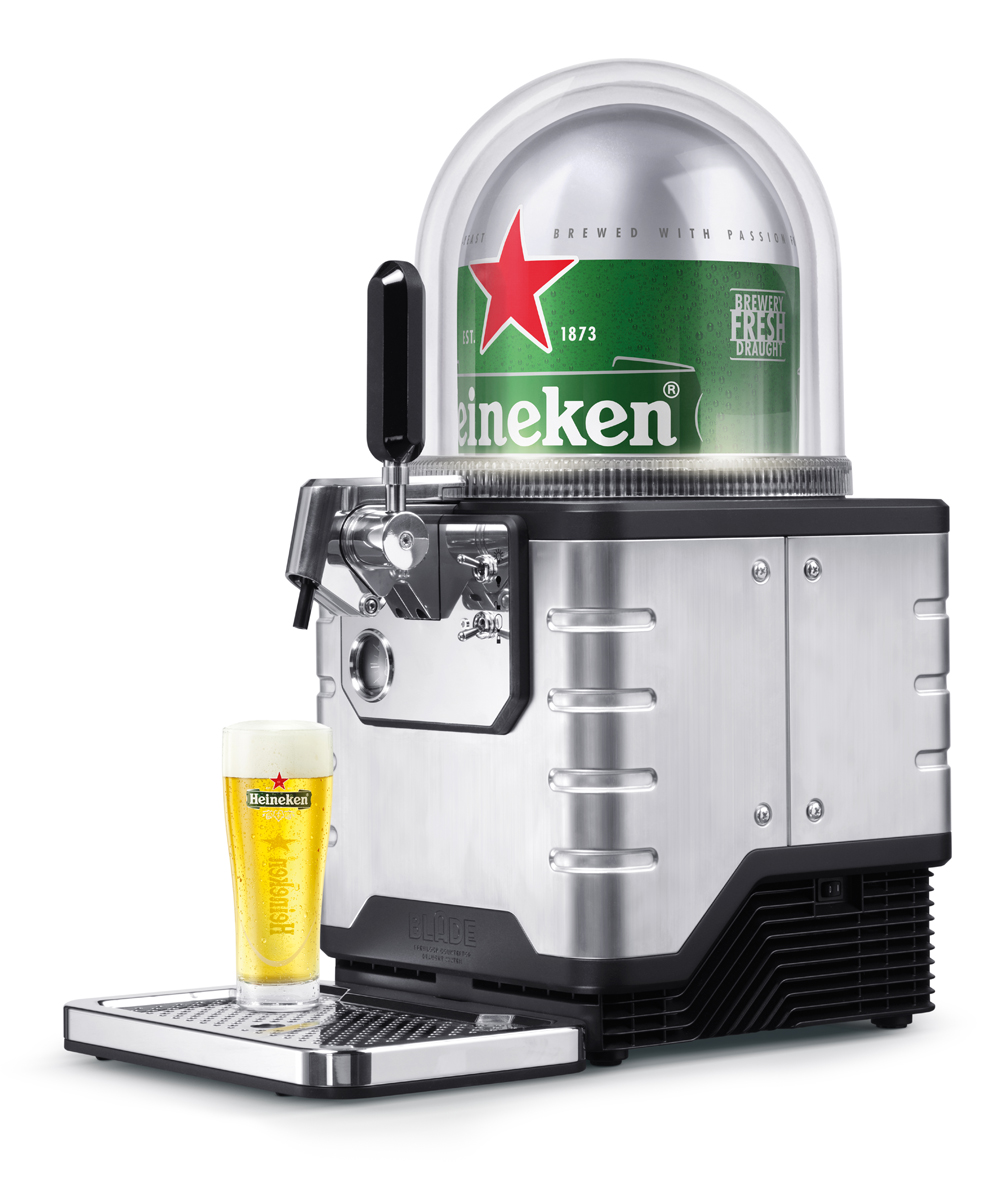
Interested in more content like this? Click here for a free subscription to our monthly magazine.


